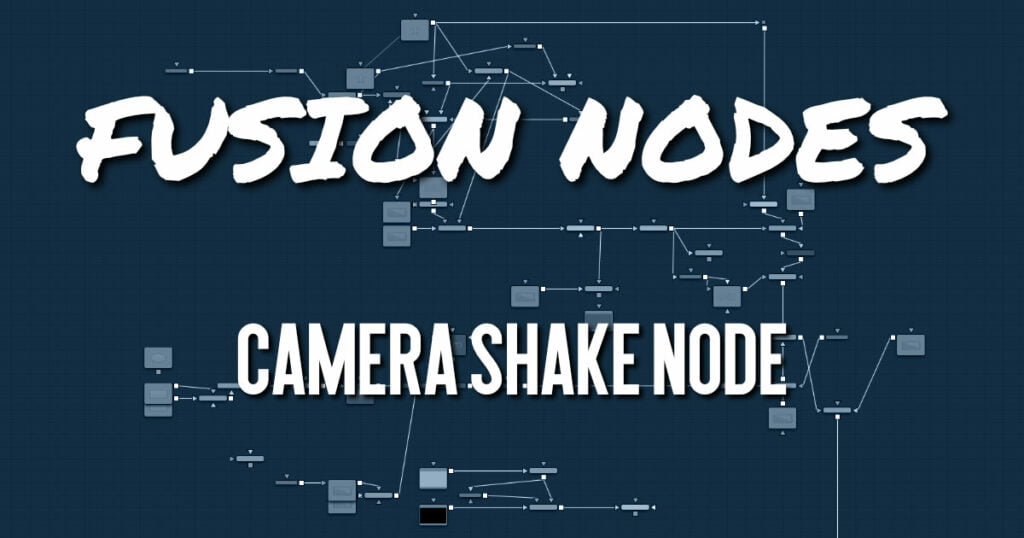Your cart is currently empty!
Camera Shake Node

This node can simulate a variety of camera shake-style motions from organic to mechanical. It is not the same as the Shake Modifier, which generates random number values for parameters. For more information on the Shake modifier, see Chapter 61, “Modifiers,” in the Fusion Reference Manual or Chapter 121 in the DaVinci Resolve Reference Manual. The Camera Shake node concatenates its result with adjacent transformation nodes for higher-quality processing.
Camera Shake Node Inputs
The two inputs on the Camera Shake node are used to connect a 2D image and an effect mask, which can be used to limit the camera shake area.
- Input: The orange input is used for the primary 2D image that shakes.
- Effect Mask: The blue input is for a mask shape created by polylines, basic primitive shapes, paint strokes, or bitmaps from other tools. Connecting a mask to this input limits the camera shake area to only those pixels within the mask. An effects mask is applied to the tool after the tool is processed.
ADVERTISEMENT
Camera Shake Node Setup
The Camera Shake background input is used to connect the image you want to transform. Polygon masks can be connected into the occlusion mask input to identify areas the camera shake should ignore.
Camera Shake Node Controls Tab
The Controls
tab includes parameters for adjusting the offsets, strength, speed, and frequency of the simulated camera shake movement.
Deviation X and Y
These controls determine the amount of shake applied to the image along the horizontal (X) and vertical (Y) axes. Values between 0.0 and 1.0 are permitted. A value of 1.0 generates shake positions anywhere within the boundaries of the image.
Rotation Deviation
This determines the amount of shake that is applied to the rotational axis. Values between 0.0 and 1.0 are permitted.
Randomness
Higher values in this control cause the movement of the shake to be more irregular or random. Smaller values cause the movement to be more predictable.
Overall Strength
This adjusts the general amplitude of all the parameters and blends that affect in and out. A value of 1.0 applies the effect as described by the remainder of the controls.
Speed
Speed controls the frequency, or rate, of the shake.
Frequency Method
This selects the overall shape of the shake. Available frequencies are Sine, Rectified Sine, and Square Wave. A Square Wave generates a much more mechanical-looking motion than a Sine.
Filter Method
When rescaling a pixel, surrounding pixels are often used to give a more realistic result. There are various algorithms for combining these pixels, called filters. More complex filters can give better results but are usually slower to calculate.
The best filter for the job often depends on the amount of scaling and on the contents of the image itself.
- Box: This is a simple interpolation resize of the image.
- Linear: This uses a simplistic filter, which produces relatively clean and fast results.
- Quadratic: This filter produces a nominal result. It offers a good compromise between speed and quality.
- Cubic: This produces better results with continuous-tone images. If the images have fine detail in them, the results may be blurrier than desired.
- Catmull-Rom: This produces good results with continuous-tone images that are resized down. This produces sharp results with finely detailed images.
- Gaussian: This is very similar in speed and quality to Bi-Cubic.
- Mitchell: This is similar to Catmull-Rom but produces better results with finely detailed images. It is slower than Catmull-Rom.
- Lanczos: This is very similar to Mitchell and Catmull-Rom but is a little cleaner and also slower.
- Sinc: This is an advanced filter that produces very sharp, detailed results; however, it may produce visible “ringing” in some situations.
- Bessel: This is similar to the Sinc filter but may be slightly faster.
Window Method (Sinc and Bessel Only)
Some filters, such as Sinc and Bessel, require an infinite number of pixels to calculate exactly. To speed up this operation, a windowing function is used to approximate the filter and limit the number of pixels required. This control appears when a filter that requires windowing is selected.
- Hanning: This is a simple tapered window.
- Hamming: Hamming is a slightly tweaked version of Hanning that does not taper all the way down to zero.
- Blackman: A window with a more sharply tapered falloff.
- Kaiser: A more complex window with results between Hamming and Blackman.
Most of these filters are useful only when making an image larger. When shrinking images, it is common to use the Bi-Linear filter, however, the Catmull-Rom filter will apply some sharpening to the results and may be useful for preserving detail when scaling down an image.
Edges
This menu determines how the Edges of the image are treated.
- Canvas: This causes the edges that are revealed by the shake to be the canvas color—usually transparent or black.
- Wrap: This causes the edges to wrap around (the top is wrapped to the bottom, the left is wrapped to the right, and so on).
- Duplicate: This causes the Edges to be duplicated, causing a slight smearing effect at the edges.
- Mirror: Image pixels are mirrored to fill to the edge of the frame.
Invert Transform
Select this control to Invert any position, rotation, or scaling transformation. This option might be useful for exactly removing the motion produced in an upstream Camera Shake.
Flatten Transform
The Flatten Transform option prevents this node from concatenating its transformation with adjacent nodes. The node may still concatenate transforms from its input, but it will not concatenate its transformation with the node at its output.
ADVERTISEMENT
Camera Shake Node Settings Tab
The Settings tab in the Inspector is also duplicated in other Transform nodes. These common controls are described in detail the Transform Common Controls.
ADVERTISEMENT










